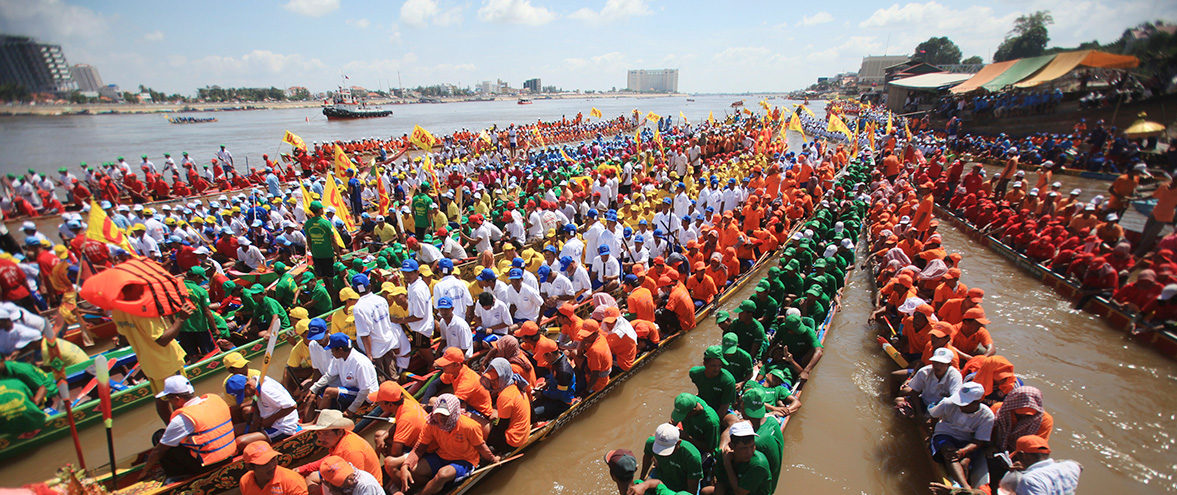
Bon Om Tuk: Everything You Need to Know about Cambodia’s Water Festival
One of the most fun and unique festivals in Cambodia, Bon Om Tuk is a three-day holiday, and it’s celebrated every year in late October or early November. In 2025, the holiday will fall from November 4 to 6.
The festival commemorates the end of the rainy season (or ‘monsoon season’) and the onset of the harvest season… and it often corresponds with the lunar Mid-Autumn Festival.
Packed with fireworks, festivities and boat races, it’s one of Cambodia’s biggest holidays, and loads of exciting stuff happens across the nation. During these three days, the people of Cambodia finally get to celebrate the end of the disruptive rains of the monsoon season, and the tasty soon-to-come flavors of the approaching harvest season.
Bon Om Tuk also marks the bizarre direction-change of the Tonle Sap River, a unique natural phenomenon that doesn’t happen anywhere else on the planet. When the monsoon period stops, the Tonle Sap begins flowing back towards the sea (instead of being forced upstream by the intensity of the season’s heavy rains).
What Happens During Phnom Penh’s Bon Om Tuk Boat Races?
Bon Om Tuk is most well-known for being marked by the dragon boat races, which take place on Phnom Penh’s Tonle Sap river (though some littler towns also host smaller versions of the same thing).
These colorful boat races feature enormous traditional-style boats, which are decorated in a similar way to the sprawling temples at world-famous Angkor Wat.

These boats are usually carved and painted by hand, while glamorously-dressed women often dance on the bows of the boats mid-race. The majority of the time, each boat represents the people of a village, town or city, and local riders compete on behalf of wherever they live.
The hefty behemoths can often fit up to 100 people (or more).
These boat-racing traditions have a lengthy history and heritage—boat racing of this type is believed to have been celebrated in Cambodia since at least the reign of Jayavarman VII* in 1181 AD.
*In case you don’t know, Jayavarman VII was a key figure in making Cambodia a largely-Buddhist place… and historians believe he was one of the most powerful monarchs in all of the nation’s history.
What Else Happens During Bon Om Tuk?
Aside from all the boat-based stuff, there’s plenty more to enjoy.
Throughout the nation, there are various fireworks displays, but the biggest are in the nation’s capital. Here, you’ll see the Phnom Penh fireworks, while large lanterns float lazily down the river on brightly-lit boats. According to local legend, these lantern-laden vessels carry bad luck away with them, leaving behind good tidings and positive omens for the coming year.
The festival also features the ceremonies of Sampeah Preah Khae, when the bright face of the so-called harvest moon is honored by locals—this full moon is thought to be a promising sign of a bountiful forthcoming crop. Locals leave food and gifts outside of their homes, and visit local temples to offer prayers and thanks.
Like with any other festival, food always plays a role. Omnipresent sweet treat Og Ambok (a traditional snack made from flattened rice, and usually enjoyed with bananas and coconut) is greedily gobbled up. Meanwhile, the streets of every town and city are lined with lots of tasty traditional food.
Lastly, across the nation, you’ll find games, dances, music performances, carnival rides, street food, prayers, traditional chants, old-school songs, illuminations, an enticing atmosphere, and a whole load of smiling faces.
No matter which part of the nation you visit, you’ll see endless local people enjoying time with family and friends… and you’ll always find a warm, welcoming and friendly atmosphere.
No matter which part of the nation you visit, you’ll see endless local people enjoying time with family and friends.
Which Part of Cambodia Should I Visit for Bon Om Tuk?
Because it’s a nationwide celebration, any part of Cambodia can be a great place to enjoy Bon Om Tuk. But no matter where you go, you should definitely experience Cambodia during the festival—visiting during this period is completely unlike visiting during any other time of year.
Most tourists understandably choose to spend the festival in Cambodia’s capital of Phnom Penh, because the banks of the Tonle Sap river play host to lots of events and activities. During this time, it’s thought that at least 1 million people (in addition to the city’s already-massive normal population!) descend upon the city to enjoy all the fun and festivities.

But we think it’s often best to enjoy Bon Om Tuk in a smaller place, where the celebrations retain some of their traditional charm. Somewhere like Kampot (or nearby Kep!) is a great place to enjoy the festival.
Although Phnom Penh’s Bon Om Tuk is full of fun, it’s often overwhelming and way too busy… so going somewhere small instead can be an intelligent choice, and offer a nice change of pace.
If you visit Kampot during Bon Om Tuk, you can enjoy lanterns, illuminations, small-scale celebrations, firefly-filled river cruises, and lots of friendly faces. And as a nice bonus, you can also get involved in lots of fun-filled water activities at Amber Kampot (our luxurious riverside hotel, sitting in a pretty part of the town).
We offer water skiing, wakeboarding, knee boarding, jet skiing, banana boats, speedboats, cocktail-packed sunset boat rides, and plenty more.
Our resort is a great place to enjoy this important public holiday in Cambodia. If you want to see a local and laconic side of the festival, there’s no better location to do it.
The wet and wacky Bon Om Tuk water festival is one of six important celebrations in Cambodia. To learn about the other five, have a sneaky peek at our guides to Khmer New Year, Bon Pchum Ben (the revered and respected Ancestors’ Festival), Cambodian Independence Day, Victory Over Genocide Day, and Vesak Bochea (Buddhist Day).
